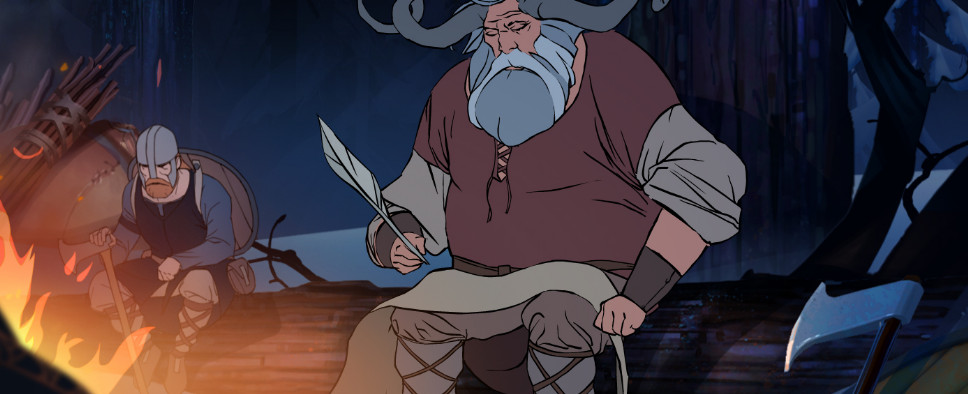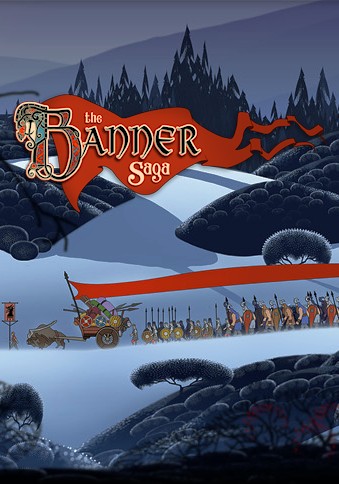The Banner Saga Review
-
Category: ReviewsHits: 12387

Article Index
Despite the abundance of these semi-random events, the game doesn't do a very good job at hiding its linearity, and occasionally struggles with making these minor events, or indeed caravan travel in general, feel like they have an impact, both in terms of emotional resonance and gameplay effects. The first time I saw some of my Clansmen were dying of starvation because I hadn't managed to secure enough supplies I got a lump in my throat, but soon it became just a number that appeared on screen, with no relevance whatsoever to the story. Even worse, letting your Clansmen die is, in many ways, advantageous: the same currency (Renown) is used to both buy supplies, upgrade your characters, and buy trinkets to assign to your characters for bonuses. Having a smaller caravan means you'll consume less supplies and have more Renown to spare to upgrade your Heroes (the characters you use in battle and that have the most relevance story-wise).
The game also uses a War sub-system during your caravan travels, sometimes pitting you in all-out battle against a very large number of enemies, the outcome of which is decided by the strategy you decide to adopt in its text interface, with your numbers compared to the enemies'. This only slightly mitigates the problem I was talking about early, as losing a War doesn't seem to have terribly weighty gameplay consequences and very rarely seems to lead to a game-over. Truth be told, should you decide to involve your Heroes in a War when given the option, the comparison between your caravan and the enemy forces would determine the number of foes you'd face, but losing battles in The Banner Saga is a common occurrence and rarely worth fretting over. Some critics would call this an example of ludonarrative dissonance, but in my opinion, it's less a case of the narrative and themes being contradicted by the gameplay, and more of a case of gameplay doing a bad job reinforcing them. That said, it's undoubtedly more satisfying to focus on The Banner Saga's overarching mournful narrative and how it develops throughout the game, rather than focus too much on its uneven gameplay aspects.
Crush Enemies, Earn Fame
Compared to other games of its ilk, Stoic's title doesn't present a large number of stats: Strength serves as both a damage stat and the hit points stand-in, Armor is subtracted from Strength before damage is applied, Break determines Armor damage, Willpower can be used to power up special abilities or make normal actions more effective, Exertion is used to determine how much Willpower can be spent on a single action, and, finally, the Ability rank is used to determine access to more powerful variants of a unit's active ability. When a character has killed enough enemies, Renown can be spent to promote him or her, but the scarcity of points granted to raise their stats and the low stat ceilings leave little wiggle room for different builds. It doesn't help that every character comes already armed with only a passive ability and an active ability that remain the same for the entire game.
A clear picture of The Banner Saga's character system is important to understands its turn-based, party-based combat system's peculiarities. At the beginning of every battle you decide which of your characters to use (for a maximum of 6), their turn order (which is subsequently unchangeable during the battle), and where to place your characters over the battlefield (the choice is limited depending on the map and enemy placement). Rather than using an initiative system of any kind, Stoic opted for a vaguely chess-like setup where every player turn is followed by an enemy turn, regardless of the difference in numbers. The only exception to this fixed sequence is Pillage mode, which usually triggers during the final phases of the battle, specifically when one of the two sides has only one character left, and grants the other side a turn for each of their characters before the sole enemy survivor gets a turn. To give an example, if the player has only one unit left, but the AI has 3 characters still alive, the AI will get to use all three characters before the player will be granted another turn, and this new turn order will be kept until the end of the battle.
During each of these turns a character gets the chance to move once and/or take an action, though turns can also be ended prematurely if none of the options look useful. Actions encompass attacking an enemy's Strength or Armor (prioritizing between the two is the bread and butter of the game's combat), using special abilities, and, for stationary characters, resting to recover Willpower. Given Strength is both the damage stat and the hit points equivalent, crippling, rather than killing an enemy becomes the basic strategy: it forces the AI to waste a turn on a liability rather than moving a more effective character. Killing an enemy before the ending phase of the battle can still be useful, as it earns Renown and adds a star to your Horn, which can be later used to add Willpower to a character, but is markedly less so than in any other tactical turn-based title I've ever played. In fact, killing enemies carelessly can even be detrimental to overall success in battles, especially during the harder encounters.
While that might sound a bit convoluted and counter-intuitive, The Banner Saga's combat still manages to shine often. Using your character's abilities in synergy, exploiting the enemy units' passive abilities and AI quirks, judging when to spend resources, these are only a few of the important skills you might (and should) pick up while playing. When at its best, the game's battles feel open-ended and engaging, and using the tools at your disposal to come up with a strategy to best the enemies is genuinely entertaining, but as the hours pass a certain feeling of repetitiveness sets in. It's true that the game varies the enemy placements, numbers and classes fairly often, mixing and matching with impunity, but all encounters are still essentially approached the same way. There's also an aesthetic factor (and aesthetics are an important element in The Banner Saga): a lot of the enemy types look very similar, and most maps have fairly mundane art to go with fairly mundane layouts.


